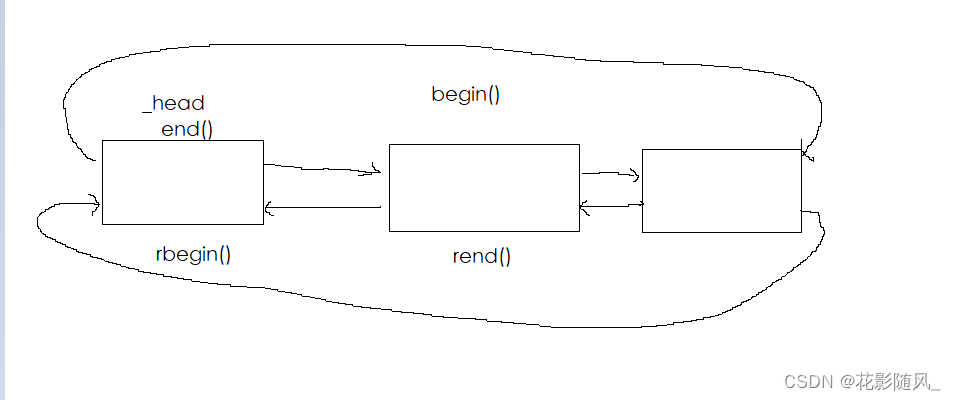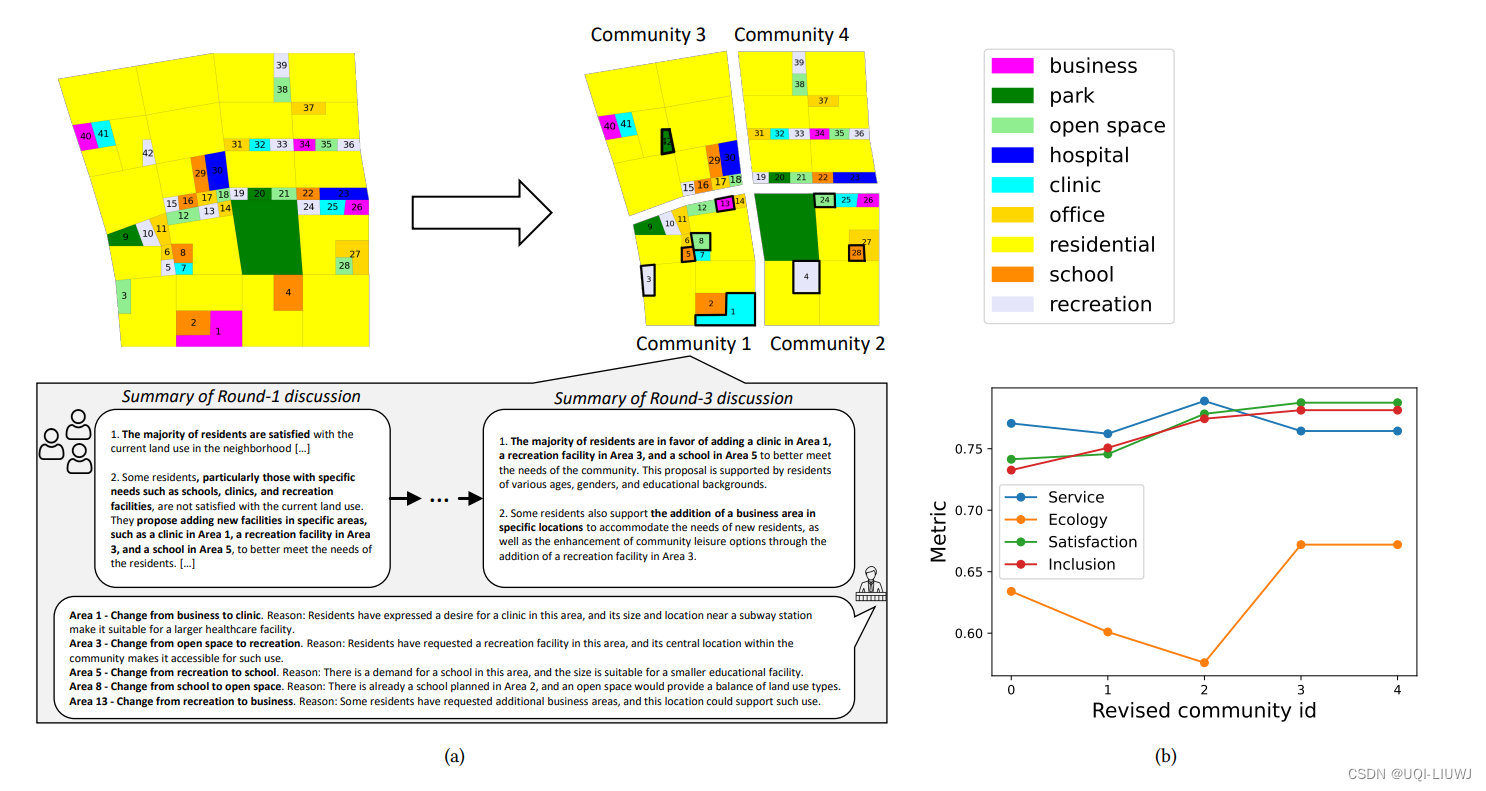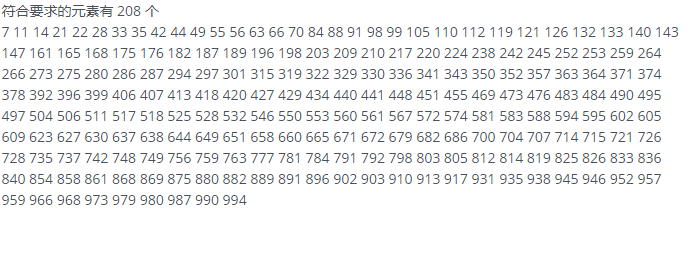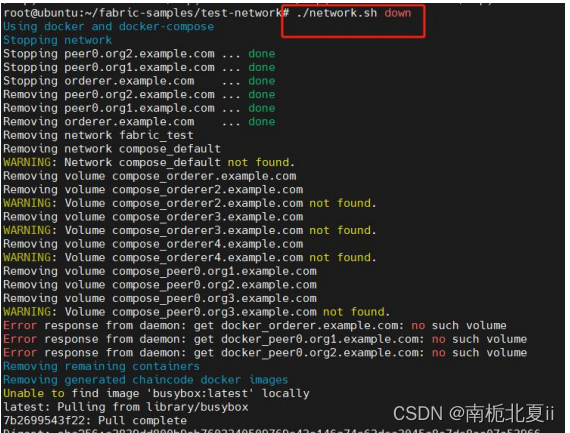1. list的介绍及使用
1.1 list的介绍
1. list是可以在常数范围内在任意位置进行插入和删除的序列式容器,并且该容器可以前后双向迭代。
2. list的底层是双向链表结构,双向链表中每个元素存储在互不相关的独立节点中,在节点中通过指针指向其前一个元素和后一个元素。
3. list与forward_list非常相似:最主要的不同在于forward_list是单链表,只能朝前迭代,已让其更简单高效。
4. 与其他的序列式容器相比(array,vector,deque),list通常在任意位置进行插入、移除元素的执行效率更好。
5. 与其他序列式容器相比,list和forward_list最大的缺陷是不支持任意位置的随机访问,比如:要访问list的第6个元素,必须从已知的位置(比如头部或者尾部)迭代到该位置,在这段位置上迭代需要线性的时间开销;list还需要一些额外的空间,以保存每个节点的相关联信息(对于存储类型较小元素的大list来说这可能是一个重要的因素)
1.2 list的使用
1.2.1 list的构造
list (size_type n, const value_type& val = value_type()) 构造的list中包含n个值为val的元素list() 构造空的list
list (const list& x) 拷贝构造函数
list (InputIterator first, InputIterator last) 用[first, last)区间中的元素构造list
void TestList1()
{list<int> l1; // 构造空的l1list<int> l2(4, 100); // l2中放4个值为100的元素list<int> l3(l2.begin(), l2.end()); // 用l2的[begin(), end())左闭右开的区间构造l3list<int> l4(l3); // 用l3拷贝构造l4// 以数组为迭代器区间构造l5int array[] = { 16,2,77,29 };list<int> l5(array, array + sizeof(array) / sizeof(int));// 列表格式初始化C++11list<int> l6{ 1,2,3,4,5 };// 用迭代器方式打印l5中的元素list<int>::iterator it = l5.begin();while (it != l5.end()){cout << *it << " ";++it;} cout << endl;// C++11范围for的方式遍历for (auto& e : l5)cout << e << " ";cout << endl;
}1.2.2 list iterator的使用
此处,大家可暂时将迭代器理解成一个指针,该指针指向list中的某个节点
begin + end 返回第一个元素的迭代器+返回最后一个元素下一个位置的迭代器
rbegin + rend 返回第一个元素的reverse_iterator,即end位置,返回最后一个元素下一个位置的reverse_iterator,即begin位置

注意:
1. begin与end为正向迭代器,对迭代器执行++操作,迭代器向后移动
2. rbegin(end)与rend(begin)为反向迭代器,对迭代器执行++操作,迭代器向前移动
// list迭代器的使用
// 注意:遍历链表只能用迭代器和范围for
void PrintList(const list<int>& l)
{// 注意这里调用的是list的 begin() const,返回list的const_iterator对象for (list<int>::const_iterator it = l.begin(); it != l.end(); ++it){cout << *it << " ";// *it = 10; 编译不通过}cout << endl;
}void TestList2()
{int array[] = { 1, 2, 3, 4, 5, 6, 7, 8, 9, 0 };list<int> l(array, array + sizeof(array) / sizeof(array[0]));// 使用正向迭代器正向list中的元素// list<int>::iterator it = l.begin(); // C++98中语法auto it = l.begin(); // C++11之后推荐写法while (it != l.end()){cout << *it << " ";++it;}cout << endl;// 使用反向迭代器逆向打印list中的元素// list<int>::reverse_iterator rit = l.rbegin();auto rit = l.rbegin();while (rit != l.rend()){cout << *rit << " ";++rit;}cout << endl;
}1.2.3 list capacity
empty 检测list是否为空,是返回true,否则返回false
size 返回list中有效节点的个数
1.2.4 list element access
front 返回list的第一个节点中值的引用
back 返回list的最后一个节点中值的引用
1.2.5 list modifiers
push_front 在list首元素前插入值为val的元素
pop_front 删除list中第一个元素
push_back 在list尾部插入值为val的元素
pop_back 删除list中最后一个元素
insert 在list position 位置中插入值为val的元素
erase 删除list position位置的元素
swap 交换两个list中的元素
clear 清空list中的有效元素
// list插入和删除
// push_back/pop_back/push_front/pop_front
void TestList3()
{int array[] = { 1, 2, 3 };list<int> L(array, array + sizeof(array) / sizeof(array[0]));// 在list的尾部插入4,头部插入0L.push_back(4);L.push_front(0);PrintList(L);// 删除list尾部节点和头部节点L.pop_back();L.pop_front();PrintList(L);
}// insert /erase
void TestList4()
{int array1[] = { 1, 2, 3 };list<int> L(array1, array1 + sizeof(array1) / sizeof(array1[0]));// 获取链表中第二个节点auto pos = ++L.begin();cout << *pos << endl;// 在pos前插入值为4的元素L.insert(pos, 4);PrintList(L);// 在pos前插入5个值为5的元素L.insert(pos, 5, 5);PrintList(L);// 在pos前插入[v.begin(), v.end)区间中的元素vector<int> v{ 7, 8, 9 };L.insert(pos, v.begin(), v.end());PrintList(L);// 删除pos位置上的元素L.erase(pos);PrintList(L);// 删除list中[begin, end)区间中的元素,即删除list中的所有元素L.erase(L.begin(), L.end());PrintList(L);
}// resize/swap/clear
void TestList5()
{// 用数组来构造listint array1[] = { 1, 2, 3 };list<int> l1(array1, array1 + sizeof(array1) / sizeof(array1[0]));PrintList(l1);// 交换l1和l2中的元素list<int> l2;l1.swap(l2);PrintList(l1);PrintList(l2);// 将l2中的元素清空l2.clear();cout << l2.size() << endl;
}1.2.6 list的迭代器失效 (难点)
我们已经说过可将迭代器暂时理解成类似于指针,迭代器失效即迭代器所指向的节点的无效,即该节点被删除了。因为list的底层结构为带头结点的双向循环链表,因此在list中进行插入时是不会导致list的迭代器失效的,只有在删除时才会失效,并且失效的只是指向被删除节点的迭代器,其他迭代器不会受到影响。
void TestListIterator1()
{int array[] = { 1, 2, 3, 4, 5, 6, 7, 8, 9, 0 };list<int> l(array, array+sizeof(array)/sizeof(array[0]));auto it = l.begin();while (it != l.end()){// erase()函数执行后,it所指向的节点已被删除,因此it无效,在下一次使用it时,必须先给
//其赋值l.erase(it); ++it;}
}
// 改正
void TestListIterator()
{int array[] = { 1, 2, 3, 4, 5, 6, 7, 8, 9, 0 };list<int> l(array, array+sizeof(array)/sizeof(array[0]));auto it = l.begin();while (it != l.end()){l.erase(it++); // it = l.erase(it);}
}所以实际上该迭代器在底层实现时,最后返回的是下一个节点的地址,所以我们每次都要给他赋值才行!!!
2. list的深度剖析及模拟实现
2.1 模拟实现list
#pragma oncenamespace bit
{template <class T>struct ListNode {ListNode<T>* _next;ListNode<T>* _prev;T _data;ListNode(const T& x = T()):_next(nullptr), _prev(nullptr), _data(x){}};// 适配器 -- 复用template<class Iterator, class Ref, class Ptr>struct Reverse_iterator{typedef Reverse_iterator<Iterator, Ref, Ptr> Self;Iterator _it;Reverse_iterator(Iterator it):_it(it){}Ref operator*(){Iterator tmp = _it;return *(--tmp);}Ptr operator->(){return &(operator*());}Self& operator++(){--_it;return *this;}Self& operator--(){++_it;return *this;}bool operator!=(const Self& s){return _it != s._it;}};template<class T, class Ref, class Ptr>struct ListIterator{typedef ListNode<T> Node;typedef ListIterator<T, Ref, Ptr> Self;Node* _node;ListIterator(Node* node):_node(node){}Ref operator*(){return _node->_data;}Ptr operator->(){return &(_node->_data);}//++itSelf& operator++(){_node = _node->_next;return *this;}Self operator++(int){Self tmp(*this);_node = _node->_next;return tmp;}Self& operator--(){_node = _node->_prev;return *this;}Self operator--(int){Self tmp(*this);_node = _node->_prev;return tmp;}bool operator!=(const Self& it){return _node != it._node;}bool operator==(const Self& it){return _node == it._node;}};//template<class T>//struct ListConstIterator//{// typedef ListNode<T> Node;// typedef ListConstIterator<T> Self;// Node* _node;// ListConstIterator(Node* node)// :_node(node)// {}// const T& operator*()// {// return _node->_data;// }// const T* operator->()// {// return &(_node->_data);// }// //++it// Self& operator++()// {// _node = _node->_next;// return *this;// }// Self operator++(int)// {// Self tmp(*this);// _node = _node->_next;// return tmp;// }// Self& operator--()// {// _node = _node->_prev;// return *this;// }// Self operator--(int)// {// Self tmp(*this);// _node = _node->_prev;// return tmp;// }// bool operator!=(const Self& it)// {// return _node != it._node;// }// bool operator==(const Self& it)// {// return _node == it._node;// }//};template<class T>class list{typedef ListNode<T> Node;public:/*typedef ListIterator<T> iterator;typedef ListConstIterator<T> const_iterator;*/typedef ListIterator<T, T&, T*> iterator;typedef ListIterator<T, const T&, const T*> const_iterator;typedef Reverse_iterator<iterator, T&, T*> reverse_iterator;typedef Reverse_iterator<const_iterator, const T&, const T*> const_reverse_iterator;reverse_iterator rbegin(){return reverse_iterator(end());}reverse_iterator rend(){return reverse_iterator(begin());}const_reverse_iterator rbegin() const{return reverse_iterator(end());}const_reverse_iterator rend() const{return reverse_iterator(begin());}iterator begin(){return _head->_next;}iterator end(){return _head;}const_iterator begin() const{return _head->_next; }const_iterator end() const{return _head;}void empty_init(){_head = new Node;_head->_next = _head;_head->_prev = _head;_size = 0;}list(){empty_init();}list(initializer_list<T> il){empty_init();for (auto& e : il){push_back(e);}}//lt2(lt1)list(const list<T>& lt){empty_init();for (auto& e : lt){push_back(e);}}void swap(list<T>& lt){std::swap(_head, lt._head);std::swap(_size, lt._size);}//lt1 = lt2;list<T>& operator=(list<T> lt){swap(lt);return *this;}void clear(){iterator it = begin();while (it != end()){it = erase(it);}}~list(){clear();delete _head;_head = nullptr;}/*void push_back(const T& x){Node* newnode = new Node(x);Node* tail = _head->_prev;tail->_next = newnode;newnode->_prev = tail;newnode->_next = _head;_head->_prev = newnode;}*/void push_back(const T& x){insert(end(), x);}void push_front(const T& x){insert(begin(), x);}void pop_back(){erase(--end());}void pop_front(){erase(begin());}void insert(iterator pos, const T& val){Node* cur = pos._node;Node* newnode = new Node(val);Node* prev = cur->_prev;//prev newnode curprev->_next = newnode;newnode->_prev = prev;newnode->_next = cur;cur->_prev = newnode;_size++;}iterator erase(iterator pos){Node* cur = pos._node;Node* prev = cur->_prev;Node* next = cur->_next;prev->_next = next;next->_prev = prev;delete cur;_size--;return iterator(next);}size_t size() const{return _size;}bool empty(){return _size == 0;}private:Node* _head;size_t _size;};void test_list1(){list<int> lt;lt.push_back(1);lt.push_back(2);lt.push_back(3);lt.push_back(4);lt.push_back(5);list<int>::iterator it = lt.begin();while (it != lt.end()){//*it += 10;cout << *it << " ";++it;}cout << endl;lt.push_front(10);lt.push_front(20);lt.push_front(30);for (auto e : lt){cout << e << " ";}cout << endl;lt.pop_back();lt.pop_back();lt.pop_front();lt.pop_front();for (auto e : lt){cout << e << " ";}cout << endl;}struct A{int _a1;int _a2;A(int a1 = 0, int a2 = 0):_a1(a1), _a2(a2){}};void test_list2(){list<A> lt;A aa1(1, 1);A aa2 = { 1, 1 };lt.push_back(aa1);lt.push_back(aa2);lt.push_back(A(2, 2));//匿名对象lt.push_back({ 3, 3 }); //单参数类型构造函数支持隐式类型转换,多参数也可以支持lt.push_back({ 4, 4 });A* ptr = &aa1;(*ptr)._a1;ptr->_a1;list<A>::iterator it = lt.begin();while (it != lt.end()){//*it += 10;//cout << (*it)._a1 << ":" << (*it)._a2 << endl;cout << it->_a1 << ":" << it->_a2 << endl;//编译器帮我们省略了一个->方便我们使用cout << it.operator->()->_a1 << ":" << it.operator->()->_a2 << endl;++it;}cout << endl;}//void PrintList(const list<int>& clt)//{// list<int>::const_iterator it = clt.begin();//权限可以缩小,不可变大// while (it != clt.end())// {// //*it += 10;// cout << *it << " ";// ++it;// }// cout << endl;//}void PrintList(list<int>& clt){list<int>::reverse_iterator it = clt.rbegin();//权限可以缩小,不可变大while (it != clt.rend()){//*it += 10;cout << *it << " ";++it;}cout << endl;}void test_list3(){list<int> lt;lt.push_back(1);lt.push_back(2);lt.push_back(3);lt.push_back(4);lt.push_back(5);PrintList(lt);list<int> lt1(lt);PrintList(lt1);}
}2.2 list的反向迭代器
namespace bit
{// 适配器 -- 复用template<class Iterator, class Ref, class Ptr>struct Reverse_iterator{typedef Reverse_iterator<Iterator, Ref, Ptr> Self;Iterator _it;Reverse_iterator(Iterator it):_it(it){}Ref operator*(){Iterator tmp = _it;return *(--tmp);}Ptr operator->(){return &(operator*());}Self& operator++(){--_it;return *this;}Self& operator--(){++_it;return *this;}bool operator!=(const Self& s){return _it != s._it;}};// vector和list反向迭代器实现
}这是一个通用的反向迭代器!!!
我们可以看到其底层是怎么样来实现这样的功能的!!!
3. list与vector的对比
| vector | list | |
| 底 层 结 构 | 动态顺序表,一段连续空间 | 带头结点的双向循环链表 |
| 随 机 访 问 | 支持随机访问,访问某个元素效率O(1) | 不支持随机访问,访问某个元素效率O(N) |
| 插 入 和 删 除 | 任意位置插入和删除效率低,需要搬移元素,时间复杂 度为O(N),插入时有可能需要增容,增容:开辟新空 间,拷贝元素,释放旧空间,导致效率更低 | 任意位置插入和删除效率高,不需要搬移元素,时间复杂度为 O(1) |
| 空 间 利 用 率 | 底层为连续空间,不容易造成内存碎片,空间利用率 高,缓存利用率高 | 底层节点动态开辟,小节点容易造成内存碎片,空间利用率低,缓存利用率低 |
| 迭 代 器 | 原生态指针 | 对原生态指针(节点指针)进行封装 |
| 迭 代 器 失 效 | 在插入元素时,要给所有的迭代器重新赋值,因为插入 元素有可能会导致重新扩容,致使原来迭代器失效,删除时,当前迭代器需要重新赋值否则会失效 | 插入元素不会导致迭代器失效,删除元素时,只会导致当前迭代器失效,其他迭代器不受影响 |
| 使 用 场 景 | 需要高效存储,支持随机访问,不关心插入删除效率 | 大量插入和删除操作,不关心随机访问 |






